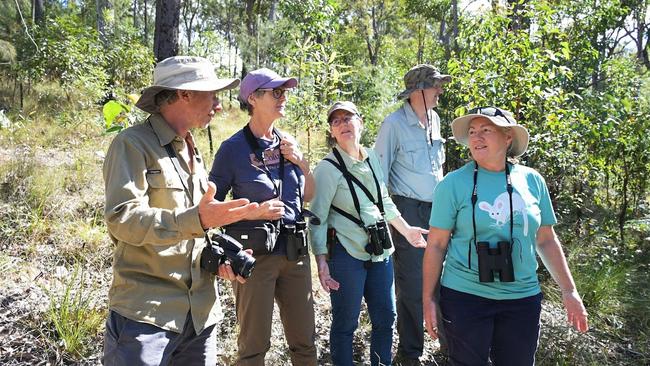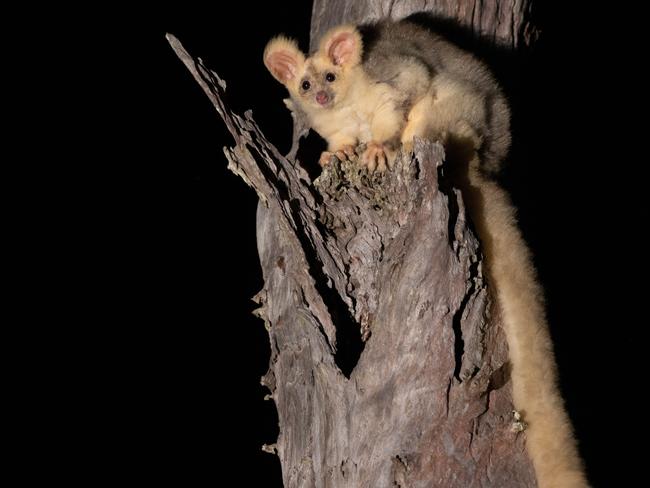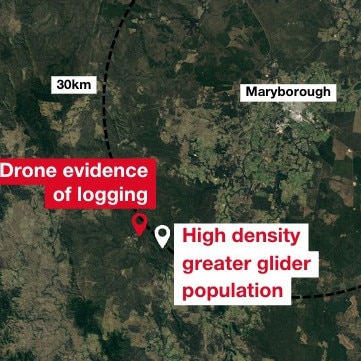Concerns raised about endangered gliders in forest near Maryborough
A conservation group claims the habitat of endangered gliders is being impacted by logging in a forest near Maryborough.
Fraser Coast
Don't miss out on the headlines from Fraser Coast. Followed categories will be added to My News.
Concerns have been raised about logging allegedly endangering the habitat of greater gliders in a forest near Maryborough.
The matter was raised by the Queensland Conservation Council, which claimed to have video and photo evidence of logging occurring in the habitat of endangered greater gliders in publicly owned native forests, shortly after the government promised a greater glider forest park would be created.
A team of volunteer experts and citizen scientists went to St Mary State Forest near Maryborough at the end of July 2024, according to a statement from QCC, and discovered a high-density population of the endangered greater glider – a species which is native to Queensland and on the decline across the country.
QCC and wildlife experts have called for protection of all greater glider habitat on state-owned land and a commitment to fund new national parks and protected areas dedicated to the species’ recovery.
More than 7000ha of St Mary State Forest, and a total of 81,000ha of core greater glider habitat in the Eastern Hardwoods forestry region are proposed by QCC for inclusion in the state government’s Greater Glider Forest Park announced in June.

Nicky Moffat, a QCC protected areas campaigner and forestry graduate of Australian National University described the footage as “damning” evidence that endangered greater gliders were at direct risk from logging taking place in state forests.
“In this special forest that is slated for logging, we just spotted seven greater gliders,” she said.
“We found a recent logging incident just a couple of kilometres away and can see on government maps this forest is under no form of protection.
“Who’s to say how much longer those trees will remain standing, that are home to the iconic greater gliders we had the pleasure to see?
“What is happening in these logging sites is not forestry – it’s vandalism.
“We’re concerned that if we raise the profile of these forests, they’ll be targeted intensively for logging.
“It’s sad but we’re in a bind because the Queensland forestry department hasn’t been doing its job, it should know where these endangered animals are and that logging their homes is not going to help recover the species.
“Logging is incompatible with protecting greater gliders. When their habitat is logged, greater gliders die.

“They rely on hollows in old eucalypt trees to nest in, and a precise mix of favourite feed tree species. If we cut down those trees, they won’t regrow for many decades and the species will disappear in that time. It takes more than 100 years for hollows to form in eucalypts.
“Our state would generate more jobs by protecting its key asset – nature – and celebrating tourism and conservation, than by mining these assets for timber that we don’t need.
“Planted forests are the future of a sustainable timber industry, and already supply 90 per cent of Queensland’s timber market.
“Forestry should be about growing timber for future generations to harvest. Queensland gave up on real forestry more than two decades ago when it stopped measuring and modelling native forests for future timber supply.
“Vast areas of new national parks are needed to protect the greater glider, as well as a significant boost in funding to care for these world class protected areas, which protect and celebrate the natural and cultural values that make Queensland so special.”
Matt Cecil, Wildlife Preservation Society of Queensland Project Manager, said the glider was on track to become extinct as a result of habitat loss and the changing climate.
“Disturbing the habitat of an endangered species is not acceptable,” he said.
“The protection of habitat is critical for their conservation and persistence.
“Logging within greater glider habitat impacts the species’ ability to move safely through their home range and leads to a loss of tree hollows.

“Greater gliders don’t cope well with habitat disturbances like human-caused logging.
“They are not inclined to travel far across open ground to move between trees.
“They require connected, mature eucalypt forest with a high proportion of large tree hollows, and feed almost exclusively on eucalypt leaves.
“Unfortunately, greater glides are not afforded the same level of popularity and exposure here in southeast Queensland as the koala, yet they are on the path to extinction, just the same.
“The endangered greater glider needs a funding and conservation investment like that which SEQ’s koalas have received in recent years.
“This species requires a genuine commitment from the State Government to ensure the greater glider population increases – a commitment that greater glider habitat will no longer be cleared, but strategically increased.”
A Department of Agriculture and Fisheries said the department acknowledged the vital role of native forests in supporting biodiversity, including glider habitats.
“Only selective harvesting is practised in State forests, which retains a viable forest after harvesting,” he said.
“The State forests near Maryborough have been subject to multiple selective harvests in the past.
“Specific protections for gliders have been in place since 2000, and we have recently introduced additional measures to better protect gliders and their habitat.
“Details of the new glider protection measures and the independent Glider Risk Assessment that they’re based on are available on DAF’s website.
“DAF would like to remind any visitors to State forests of the potential dangers associated with visiting forestry operations and the need to comply with any harvesting safety signs.”
Isis Mill offers $250,000 for farmers to plant more cane
Man rushed to hospital with ‘significant burns’ caused by backyard fire




